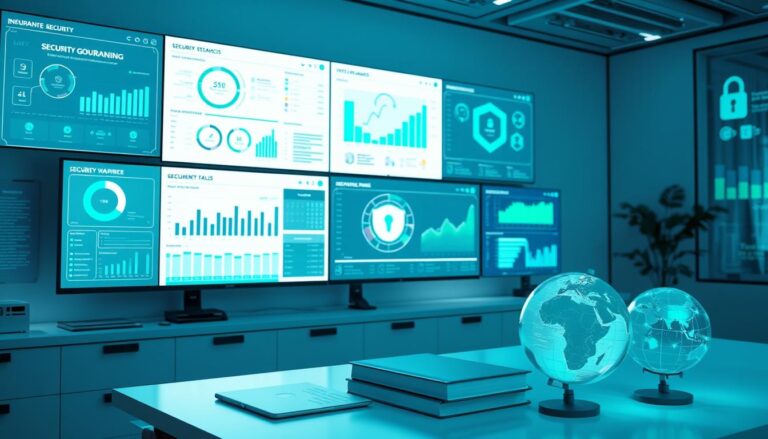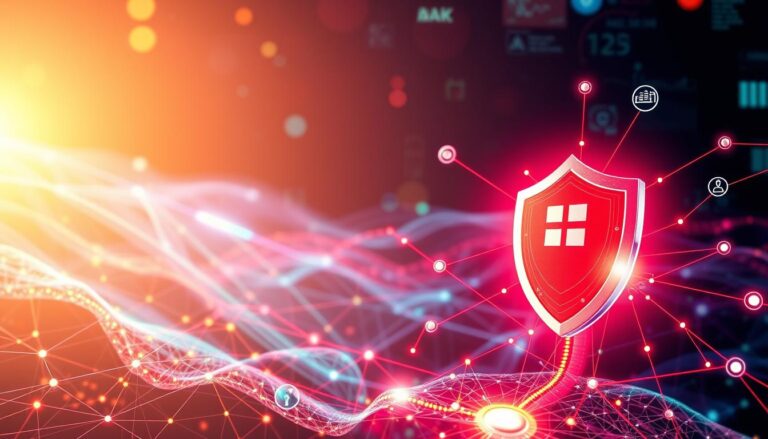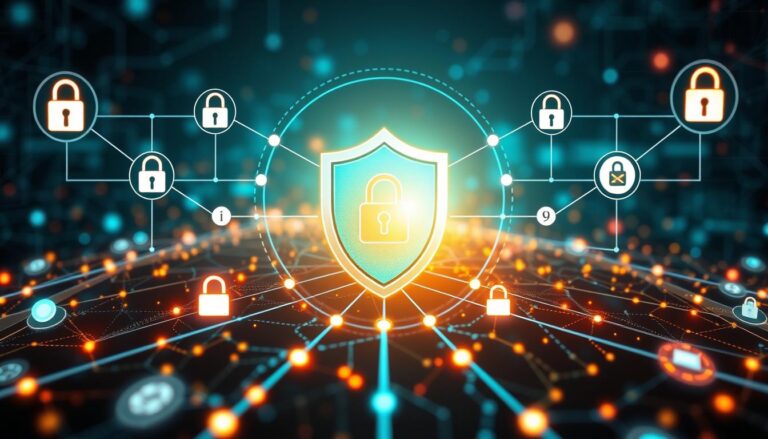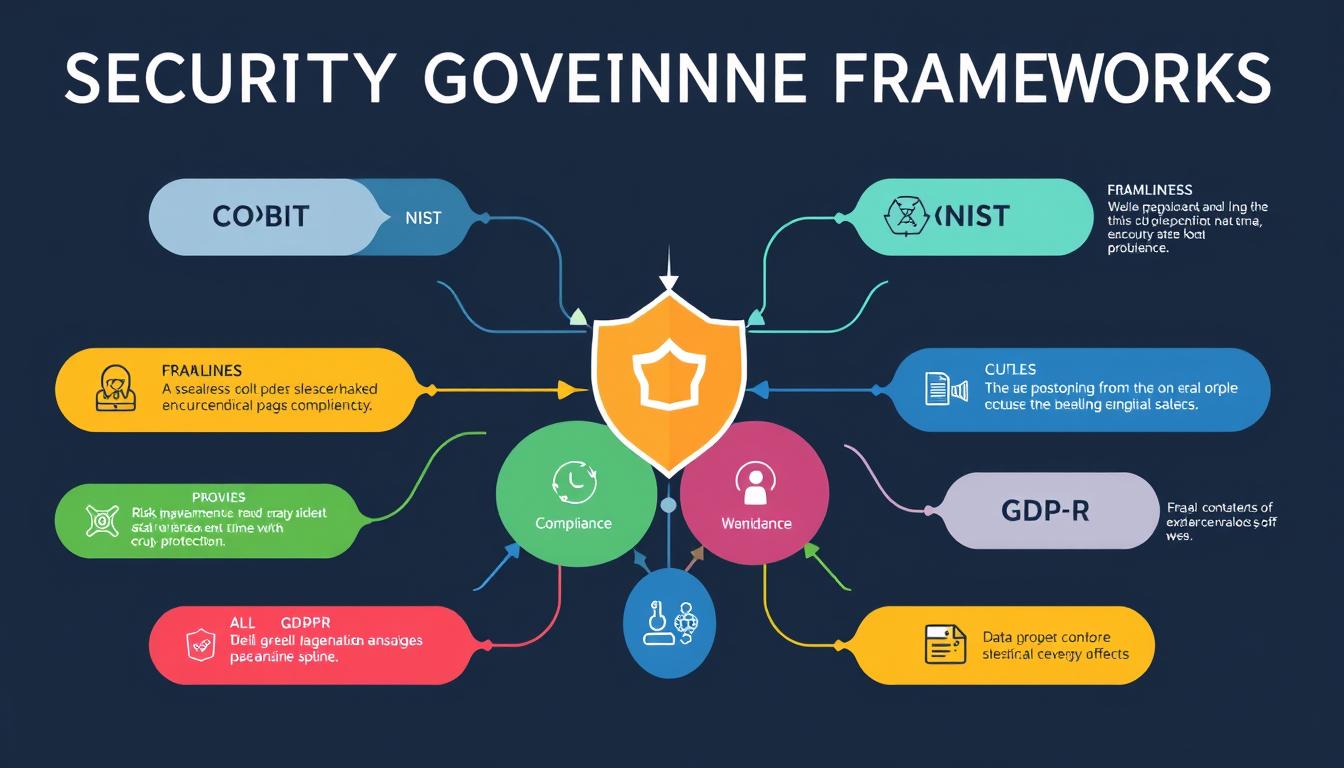
Did you know that over the last decade, the demand for security and compliance certifications has surged dramatically? This has greatly influenced contract awards for SaaS and service providers. The growing emphasis on compliance shows how vital strong security governance frameworks are in today’s digital world.
As organizations face a complex array of cybersecurity threats, it’s key to understand the different security governance frameworks. In this guide, we’ll look at top frameworks like NIST, ISO/IEC 27001, and COBIT, as well as practical applications like CIS Controls. We aim to show you the best security frameworks for your organization’s specific needs.
By exploring these cybersecurity governance frameworks, we’ll shed light on their strengths, weaknesses, and best uses. This will help pave the way for a more secure future for all.
Introduction to Security Governance Frameworks
Security governance frameworks offer structured ways to handle cybersecurity risks. Today, digital threats are everywhere, putting our data and systems at risk. It’s vital for companies to focus on strong security governance to protect their digital assets.
These frameworks help companies set up solid security plans and practices. For example, the NIST Cybersecurity Framework guides risk management through five steps: identify, protect, detect, respond, and recover. It makes sure security efforts match the company’s goals, showing how important good governance is.
Recently, big data breaches like the Marriott Hotel hack and the Twitter leak have shown we need better security. Using security governance frameworks helps companies manage their cybersecurity better. This way, they can defend against threats more effectively.
Investing in security governance frameworks helps reduce cybersecurity risks. It also makes sure companies follow important IT security standards like PCI DSS and GDPR. Companies that use these frameworks can build a strong base for managing risks and improving security over time.
Understanding the Importance of Security Governance
Today, it’s key for organizations to understand the role of security governance. Using strong cybersecurity frameworks protects valuable assets and meets legal standards. With more cyber threats and rules, having a good governance system is essential.
Recent surveys show that 52% of companies see security governance as vital for following rules. About 70% of clients ask for a SOC 2 report in contracts. Many face challenges in managing different rules, with over 60% finding it hard.
Healthcare groups, with their strict rules, show the high stakes. 77% must follow HIPAA, and HITRUST for health data security. This shows the need for good governance, as 72% of firms see better control efficiency.
Without good governance, risks are high. For instance, 65% of companies with a governance strategy reduce data breach risks. Yet, 58% of firms trying multiple frameworks find it inefficient.
- As new client contracts emerge, nearly 40% of companies will need to produce compliance reports by year-end.
- About 85% of organizations analyze multiple compliance frameworks like GDPR and PCI within their governance strategies.
- Research indicates that 82% of businesses feel more secure after implementing a suitable governance framework.
- External compliance consultants are favored by up to 90% of companies, expediting their governance development.
NIST SP 800 Series Overview
The NIST SP 800 series was started by the National Institute of Standards and Technology in 1990. It is key for security governance. It began with federal information systems but now helps the private sector too. It offers a security standards comparison to show the best in cybersecurity.
This series has many publications on information security. Topics include cloud security, compliance, and risk management.
Key Features of NIST SP 800 Series
The NIST SP 800 series is known for its detailed framework. It outlines security and privacy controls for organizations. These controls meet strict federal standards.
Some key features are:
- Benchmarking: NIST SP 800-53 is a benchmark for U.S. government agencies. It’s also used in the private sector.
- Compliance Framework: NIST SP 800-171 helps defense contractors meet U.S. Department of Defense mandates.
- Risk Management Focus: The NIST CSF framework uses risk management’s five phases: identify, protect, detect, respond, and recover.
- Annual Reports: The NIST SP 800 series annual reports update on cybersecurity threats and best practices.
Best Use Cases for NIST SP 800 Series
The NIST SP 800 series is very useful in certain situations. It’s great for:
- Organizations with government contracts needing to follow strict federal standards.
- Industries looking to boost their cybersecurity, using detailed guidelines.
- Entities comparing security governance models, using the NIST SP 800 framework as a guide.
| Publication | Focus Area | Target Audience |
|---|---|---|
| NIST SP 800-53 | Security controls | Federal agencies, private sector |
| NIST SP 800-171 | Compliance guidelines | Defense contractors |
| NIST SP 800-37 | Risk management framework | All sectors seeking complete risk management |
| NIST SP 800-30 | Risk assessment | Organizations doing risk assessments |
NIST Cybersecurity Framework (CSF) Explained
The NIST Cybersecurity Framework (CSF) is a key tool for many organizations. It helps those in industry, government, and academia. It was first made to improve the cybersecurity of critical infrastructure. Now, it helps manage cybersecurity risks for all kinds of organizations, no matter their size or technical skill.
Let’s look at what the NIST CSF does and how it helps.
Core Functions of NIST CSF
The NIST CSF has five main parts. They work together to improve cybersecurity:
- Identify: This part helps you understand your environment and risks. It covers things like Asset Management and Governance.
- Protect: This part focuses on keeping things safe. It includes Identity Management and Data Security, so critical services can keep running.
- Detect: This part is about catching cybersecurity problems early. It encourages constant checking and quick action.
- Respond: This part helps you handle communications during security issues. It also helps learn from these experiences for the future.
- Recover: This part is about getting back to normal after a security issue. It stresses the need for good recovery plans and clear communication.
Benefits for Organizations
Using the NIST CSF brings many benefits. It’s flexible, so you can tailor your cybersecurity to fit your business goals and risks. It helps you manage cybersecurity all the time, which is good for any size or type of organization.
There are resources like Quick Start Guides and examples to help you get started. The framework has levels to help you see where you are and what to do next. Using the NIST CSF means you’re ready to handle different and changing risks.
ISO/IEC 27001 Framework Overview
The ISO/IEC 27001 framework is a global standard for managing information security. It focuses on managing risks by identifying and reducing them. Companies often get certified to show they care about keeping information safe.
Risk Management Approach
ISO/IEC 27001’s risk management is thorough. It helps protect sensitive information well. By using this framework, you can meet about 83% of NIST Cybersecurity Framework (CSF) requirements. This boosts your security level.
If you follow NIST CSF, you’re about 61% on your way to ISO 27001 certification. ISO/IEC 27001 has 93 controls in four sections. These controls are key to choosing a good security framework.
ISO 27001 certification lasts three years. You need annual audits for the first two years. The third year requires a recertification audit to keep up with standards.
Using ISO/IEC 27001 shows you’re serious about information security. It also improves your operations and risk management. This framework helps you check your cybersecurity and follow best practices for keeping data safe.
| Aspect | ISO/IEC 27001 | NIST CSF |
|---|---|---|
| Primary Focus | Information Security Management | Cybersecurity Framework |
| Control Requirements | 93 Controls in Annex A | Five Core Functions |
| Compliance Process | Formal audit with external auditors | Voluntary implementation |
| Certification Validity | Three years | N/A |
CIS Controls: A Practical Approach to Cybersecurity
The CIS Controls framework is a practical way to tackle cybersecurity challenges. Over 75% of organizations struggle with effective cybersecurity frameworks. The CIS Controls shine by focusing on actionable cybersecurity best practices. They make security easier by grouping controls into three categories for different needs.
Implementation Groups of CIS Controls
The CIS Controls are split into three groups, each for specific needs:
- Implementation Group 1 (IG1): Targets small to mid-sized enterprises with limited cybersecurity knowledge. These organizations should focus on defending against non-targeted attacks using basic tools.
- Implementation Group 2 (IG2): Designed for medium-sized enterprises with some IT staff but limited resources. This group needs a more advanced approach, including complex enterprise technology.
- Implementation Group 3 (IG3): Aimed at large-scale enterprises handling sensitive data. Organizations in IG3 must implement all safeguards to protect against sophisticated attacks.
The CIS Controls include 18 controls, arranged by priority. These groups help organizations use their resources wisely. Many small to medium-sized businesses lack a solid cybersecurity plan. This structured approach helps them build a strong defense.

| Implementation Group | Target Audience | Recommended Actions |
|---|---|---|
| IG1 | Small to Mid-sized Enterprises | Defend against non-targeted attacks with basic tools. |
| IG2 | Medium-sized Enterprises | Implement more complex measures and configurations. |
| IG3 | Large Enterprises | Implement all safeguards and combat sophisticated threats. |
Aligning the CIS Controls with security frameworks like NIST CSF helps organizations improve their security. It also ensures they meet regulatory needs like SOX, HIPAA, GLBA, and PCI DSS. The CIS Controls are a key resource in cybersecurity.
COBIT Framework and Its Relevance
The COBIT framework has been key for organizations starting in 1996. It helps manage IT governance and practices. It makes sure IT works with business goals, boosting profits and efficiency.
This is also true for cybersecurity. Working with IT governance is vital for reaching goals.
Integration with IT Governance
Successful integration with IT governance under the COBIT framework helps manage IT well. COBIT’s main goals are:
- Aligning IT goals with business outcomes to enhance overall profitability.
- Bringing IT values to business operations, focusing on resource and risk management.
- Improving IT efficiency through structured governance processes.
COBIT and ITIL® frameworks have different roles. COBIT looks at governance on a big scale, while ITIL® improves IT service management. Together, they help make strong operational models.
COBIT uses a top-down approach, unlike ITIL®’s bottom-up method. This lets organizations use both frameworks to improve their security.
As IT gets more complex, the need for skilled IT service management grows. Using COBIT means working with stakeholders to set goals and benchmarks. This might need more resources.
Managing governance and operations well leads to better IT service delivery. It shows how governance frameworks and management methods work together.
Comparing the NIST SP 800 Series and NIST CSF
The comparison of security governance frameworks shows key differences between the NIST SP 800 series and the NIST Cybersecurity Framework (CSF). The NIST SP 800–53 offers over 1000 specific security controls. It’s perfect for organizations needing strict, detailed compliance. This is critical for federal agencies, where following these controls is mandatory, and not doing so can lead to big penalties.
The NIST CSF, on the other hand, has five main functions: Identify, Protect, Detect, Respond, and Recover. It’s made to be flexible and can fit organizations of all sizes and types. Unlike NIST SP 800, the NIST CSF doesn’t need formal certification. It’s great for organizations focusing on strategic cybersecurity.
When deciding between NIST SP 800 and NIST CSF, it depends on what you need. NIST SP 800 is best for those with strict compliance needs. NIST CSF is better for those wanting a flexible approach without the need for certification.
Using both frameworks together can also strengthen your cybersecurity. By mixing elements from both, you can create a strong defense that meets your specific needs.
| Feature | NIST SP 800 Series | NIST Cybersecurity Framework (CSF) |
|---|---|---|
| Detail Level | Highly detailed with over 1000 specific controls | Broad guidelines with core functions |
| Target Audience | Primarily federal agencies | Organizations of all sizes |
| Certification Requirement | Obligatory compliance for federal entities | No mandatory certification |
| Implementation Focus | Stringent compliance | Flexible and strategic approach |
| Best Use Case | Organizations needing specific compliance controls | Organizations looking for a scalable model |
Different Security Governance Frameworks Comparison: An Overview
It’s important to know the different security governance frameworks to pick the right one for your company. A detailed look at these frameworks shows their strengths and weaknesses. It also helps understand who they are for.
NIST frameworks, like NIST SP 800-53 and NIST CSF, are key for many, including government groups. NIST SP 800-53 has lots of controls for systems. NIST CSF focuses on critical areas with five main steps: Identify, Protect, Detect, Respond, and Recover.
ISO standards, like the ISO 27000 series, offer a wide range of security guidelines. For example, ISO 27018 deals with cloud computing, and ISO 27031 helps with disaster recovery. These are popular for their global acceptance, with ISO 27001 being a top choice for certification.
The Center for Internet Security (CIS) Critical Security Controls has 18 controls to boost security and manage risks. It’s great for small to medium-sized businesses looking for affordable ways to improve security.
COBIT 2019 is used to meet rules like the Sarbanes-Oxley Act (SOX). It also improves governance by combining with other frameworks like NIST or ISO 27001. This helps with better IT management and risk handling.
The table below gives a quick look at these frameworks to help you understand them better:
| Framework | Strengths | Weaknesses | Best for |
|---|---|---|---|
| NIST SP 800-53 | Wide-ranging controls, government benchmark | Complexity in implementation | Government agencies, large organizations |
| NIST CSF | Structured approach, widely applicable | Requires cultural shift | Critical infrastructure sectors |
| ISO 27000 Series | Global recognition, leads to certification | Can be resource-intensive | Multinational organizations |
| CIS Controls | Practical and cost-effective | May require customization | Small to medium-sized businesses |
| COBIT 2019 | Strong governance framework | Focus on compliance might overlook security | Organizations needing compliance with regulations |
This comparison helps you find the best framework for your needs, rules, and goals.
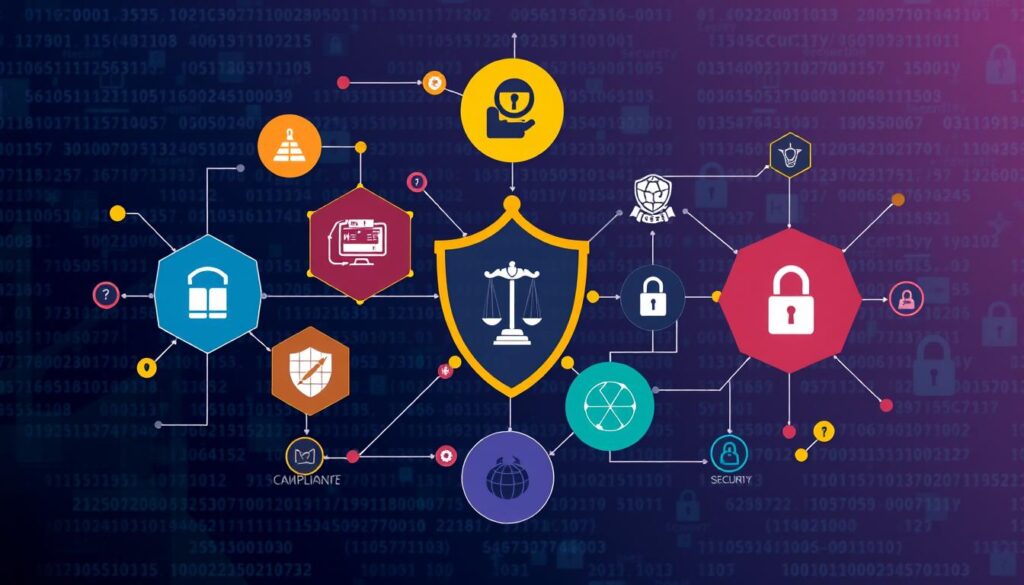
Evaluating Security Frameworks for Your Organization
Choosing the right security framework is key for protecting your data and assets. It’s important to know your specific needs and goals. Start by looking at regulatory compliance, which is essential for following legal rules in your industry. For example, HIPAA is for healthcare, and PCI DSS is for businesses handling card transactions.
The size of your organization also matters. Smaller groups might choose simpler frameworks like SOC 2. But bigger companies might prefer NIST’s Cybersecurity Framework (CSF) for its detailed risk management. Having a clear plan is a best practice for picking a framework.
How much risk you can handle is another big factor. You need to decide how much risk you can take with data breaches. NIST 800-53 offers guidelines for protecting sensitive information, which is useful for many institutions.
Industry standards are also important. For instance, financial companies might need to follow the Open Finance Data Security Standard (OFDSS). Making your framework fit your industry’s needs can strengthen your security.
Here’s a structured approach to help you evaluate frameworks. It covers key points of different frameworks, making it easier to compare:
| Framework | Regulatory Compliance | Best Use Cases | Key Considerations |
|---|---|---|---|
| NIST Cybersecurity Framework | Voluntary guidance; integrates vulnerability management | General risk management, asset management | Flexible, suitable for various cybersecurity contexts |
| SOC 2 | North America; security posture demonstration | Service organizations | Detailed reporting, less stringent for compliance |
| ISO 27001 | Global benchmark; extensive controls | Information security management | Certification requirements can be rigorous |
| PCI DSS | Mandatory for payment card transactions | Retail payment processing | Strict requirements for consumer payment protection |
| HIPAA | Legally mandated in US healthcare | Patient health data protection | Compliance is critical for operations |
By carefully looking at security frameworks, you can find the best one for your organization. This will protect your information and meet legal requirements.
Best Practices for Selecting a Security Framework
In today’s world, picking the right security framework is key to keeping your business safe from cyber threats. Knowing how to choose the best cybersecurity standards is vital. It helps protect your data and manage risks effectively.
Start by checking your current security setup. Look at your policies, procedures, and technology. This step helps find weak spots and areas for improvement. Make sure the framework you choose fits your business goals. Frameworks like ISO/IEC 27001 or the NIST Cybersecurity Framework can help a lot.
Get input from your team when picking a framework. Their opinions can help make sure it meets your needs. It’s also important to regularly check if your framework is up to date. The world of cybersecurity is always changing, so you need to stay ready to adapt.
Understanding the rules you need to follow is also important, like for businesses with sensitive data. Using well-known standards can build trust with your customers and partners. It makes choosing the right standards not just a technical task but a strategic move for your business.
Conclusion
Looking back, it’s clear that strong security governance frameworks are key for all organizations facing cyber threats. A tailored framework is vital for good cybersecurity management. Remember, having a board or governance committee is important for a framework’s success.
Statistics show that 78% of companies compare their security practices with others. This guide stresses the importance of checking your current practices and finding gaps. For companies under strict rules like HIPAA and GDPR, using frameworks like NIST SP 800–53 or ISO/IEC 27001 can boost security by up to 70%.
In short, making security a part of everything you do improves compliance and security awareness. With many frameworks to choose from, pick the one that fits your organization best. Adopting the right frameworks can greatly strengthen your cybersecurity.
Source Links
- Comparing NIST, ISO 27001, SOC 2, and Other Security Standards and Frameworks
- NIST vs. COBIT: Comparison of Cyber Security Frameworks
- COBIT vs. Other IT Governance Frameworks: A Comparative Analysis
- Understanding IT security frameworks: Types and examples
- A Guide to Information Security Governance
- 7 Cybersecurity Frameworks to Reduce Cyber Risk in 2024
- Information Security Governance: Framework for IT Compliance
- Understanding Security Frameworks: 14 Common Frameworks Explained
- Top 12 IT security frameworks and standards explained | TechTarget
- Search | CSRC
- Start Here – Governance Risk & Compliance (GRC) Content – NIST 800-53 vs ISO 27002 vs NIST CSF vs SCF
- NIST Cybersecurity Framework (CSF) Core Explained
- What is NIST Cybersecurity Framework (CSF) 2.0?
- ISO 27001 vs. NIST Cybersecurity Framework
- NIST CSF vs. ISO 27001: What’s the difference? | Vanta
- Top 11 cybersecurity frameworks in 2024
- Difference Between NIST and CIS: Choosing the Right Framework
- CIS Controls: The Critical Security Controls Explained
- COBIT vs. ITIL®: The Ultimate IT Governance Framework Comparison
- COBIT 2019 and COBIT 5 Comparison
- Top 5 Cybersecurity Frameworks: A Comprehensive Comparison
- NIST 800-53 vs NIST 800-171 : Understand the Key Difference
- NIST CSF vs. Other Cybersecurity Frameworks
- IT Governance Frameworks: A Comprehensive Guide
- Comparing Vulnerability Management Frameworks | RSI Security
- Your guide to security frameworks + examples | Vanta | Vanta
- Cybersecurity Frameworks: What They Are & How to Use Them | Splunk
- Cybersecurity Frameworks Comparison: 10 Common Frameworks – Tolu Michael
- Security Governance: Key Principles and Frameworks
- What is the difference between cyber security framework and regulation? – Cyber Upgrade
